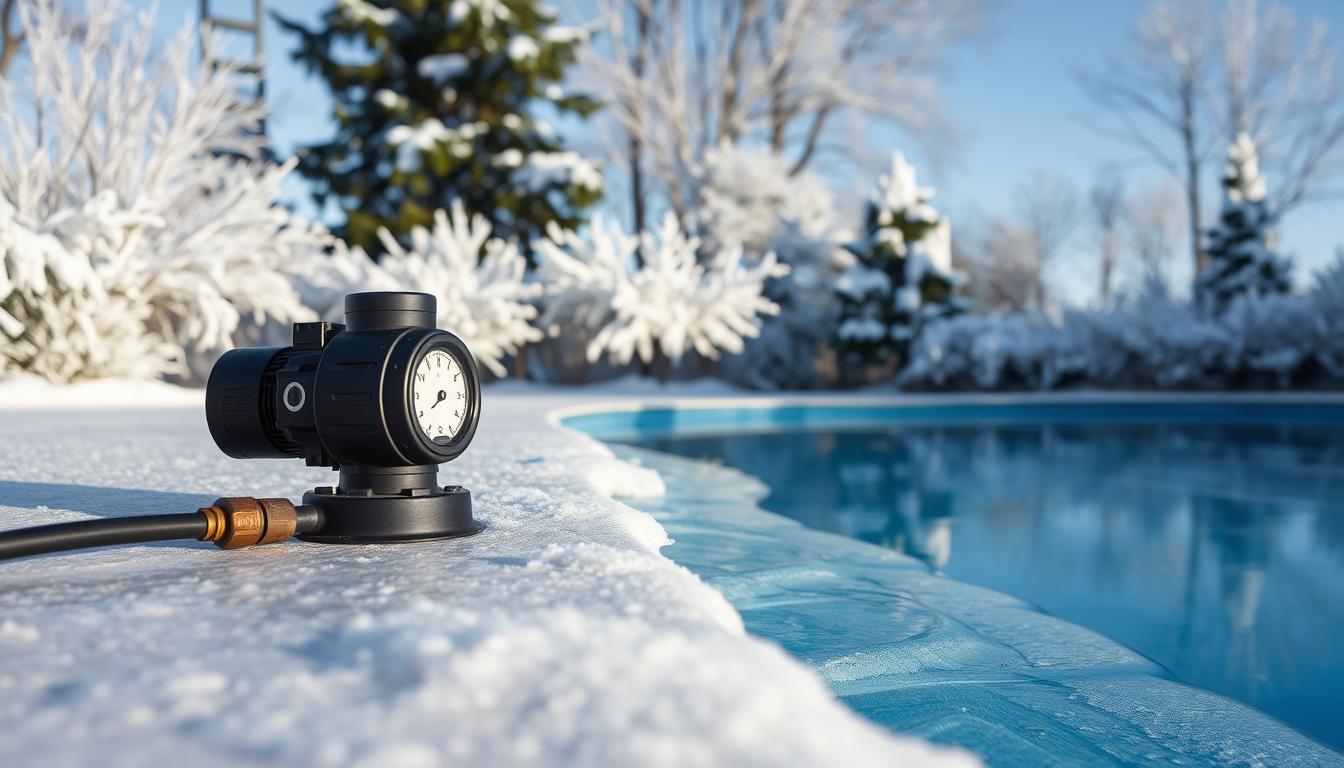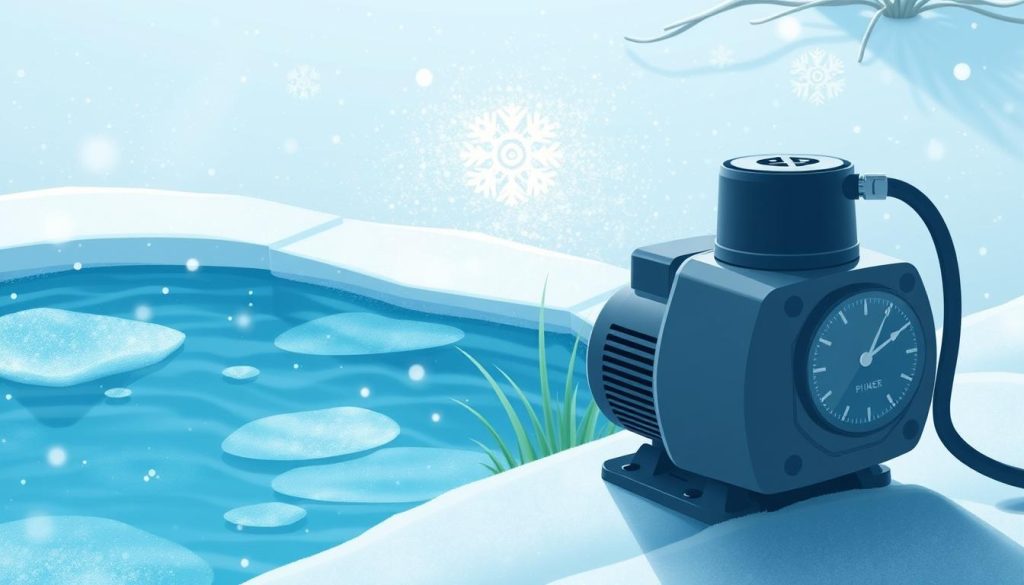
Winter’s chill brings questions about pool pump schedules. Shutting down the pump completely can cause problems in spring. Let’s explore why running your pump matters and how to set the best winter schedule.
On a frosty morning, you might wonder if your pool pump needs to run. Even when you’re not swimming, daily pump operation is crucial. It keeps your pool clean and stops algae growth.
Winterizing pool pump doesn’t mean turning it off completely. Instead, adjust the runtime to maintain a healthy pool environment. This approach ensures your pool stays in top shape throughout the cold season.
Understanding the Importance of Running Your Pool Pump in Winter
Running your pool pump in winter is crucial for maintaining water health. It keeps the pool clean even when it’s not in use. This practice is vital for winter pool maintenance.
Maintaining Pool Cleanliness and Preventing Algae Growth
Running your pool pump prevents algae growth in winter. Algae thrive in still water, so constant movement makes it harder for them to grow. This keeps your pool clean and safe.
In February 2021, Texas faced a severe winter storm damaging pool equipment. It caused burst pipes and water outages, showing the need for proper winter care. Even in Houston, freezing temperatures can harm pools.
Circulating Chlorine for Effective Sanitization
Running your pool pump in winter distributes chlorine and other chemicals evenly. This maintains consistent chemical levels throughout the water. Proper circulation keeps your pool sanitized and prevents harmful bacteria growth.
In-ground pools can last for decades with proper maintenance, but ice expansion during winter can damage the pool’s plaster, filtration system, pump, and skimmer.
Here’s a table showing important winter pool maintenance tasks:
| Pool Maintenance Task | Frequency | Benefits |
|---|---|---|
| Running pool pump | 4-6 hours per day | Circulates water and chemicals, prevents stagnation |
| Testing water chemistry | Once a week | Ensures proper chemical balance, prevents algae growth |
| Cleaning skimmers | As needed | Maintains proper water flow, prevents freezing |
Regular winter pool maintenance keeps your water clean and clear. It prepares your pool for the warm weather ahead. This effort saves time and money in the long run.
Proper care ensures your pool remains a beautiful home feature. It will be ready to enjoy when summer arrives.
Determining the Optimal Pool Pump Runtime for Winter
Pool owners must balance cleanliness and energy use in winter. Finding the right pump runtime is key. We’ll explore factors affecting circulation needs and how to calculate turnover rates.
This knowledge ensures a clean pool while saving energy. Let’s dive into the details of winter pool maintenance.
Factors Affecting Winter Pool Pump Runtime
Several factors influence ideal pump runtime in winter:
- Pool size and volume
- Pump flow rate and efficiency
- Climate and weather conditions
- Pool usage and bather load
- Chemical balance and filtration needs
Consider these variables to tailor pump runtime to your pool’s needs. Larger pools may need longer runtimes for complete turnover.
Energy-efficient variable speed pumps can reduce runtime without compromising water quality. This helps maintain a clean pool while saving energy.
Calculating Your Pool’s Turnover Rate
Turnover rate is the time it takes to circulate all pool water. To calculate, know your pool’s volume and pump’s flow rate.
Aim for one complete turnover every 4-6 hours. This ensures proper circulation and maintains water quality.
To calculate the minimum runtime hours needed, divide your pool’s volume by the pump’s flow rate (in liters per minute).
For example, a 50,000-liter pool with a 200 liters/minute pump needs 4.2 hours for one turnover. This calculation helps determine the baseline for your pump’s runtime.
Adjusting Runtime Based on Weather Conditions and Usage
Consider external factors like weather and pool usage when setting pump runtime. Cold winters may require increased runtime to maintain circulation.
Heavy pool use or storms also call for longer runtimes. Adjust based on these factors to prevent algae growth.
| Temperature | Additional Runtime |
|---|---|
| 10°C – 15°C | + 30 minutes |
| 16°C – 20°C | + 1 hour |
| 21°C – 25°C | + 1.5 hours |
| 26°C and above | + 2 hours |
Monitor weather and usage patterns to make informed decisions about pump runtime. This approach keeps your pool clean and inviting throughout winter.
By adjusting runtime as needed, you’ll optimize energy efficiency while maintaining water quality. Your pool will be ready for use, even in colder months.
How Long Should Pool Pump Run in Winter: Recommended Durations
Pool owners need to know the right winter pump runtime. This keeps the pool clean and healthy. The runtime can change based on pool size, pump type, and weather.
General guidelines can help optimize circulation and filtration. These work for most pools during colder months.

Average Runtime for Residential Pools in Winter
Most residential pools need 4 to 6 hours of pump runtime daily. This turns over the entire pool volume once. It ensures proper circulation and chemical distribution.
Larger pools or those with more swimmers may need longer runtimes. This helps maintain the best water quality.
| Pool Size | Recommended Winter Pump Runtime |
|---|---|
| Small (up to 10,000 gallons) | 4 hours per day |
| Medium (10,000 to 20,000 gallons) | 5 hours per day |
| Large (over 20,000 gallons) | 6 hours per day |
Comparing Winter and Summer Pool Pump Runtimes
Winter pool pump runtimes are usually shorter than summer ones. Summer pumps may need to run 8 to 10 hours daily. This is due to more frequent use and higher temperatures.
Winter allows for shorter runtimes. Less usage and lower temperatures still achieve the desired turnover rate.
The key to an energy-efficient pool pump schedule for winter is finding the right balance between maintaining proper water circulation and minimizing energy consumption.
Variable-speed pool pumps can help achieve this balance. They run at lower speeds for longer, reducing energy costs. This maintains good circulation while saving money.
Adjust the pump speed to your pool’s needs. This optimizes winter vs summer pump hours. It saves on costs without affecting water quality.
Tips for Efficient Pool Pump Operation During Winter Months
Regular maintenance checks on your pump and filter are crucial for efficient winter pool operation. Clear debris and clogs to maintain proper flow rates. This prevents your equipment from overworking.
Consider investing in a variable-speed pool pump. It can run longer at lower speeds, saving money on electricity costs. This type of pump still effectively circulates the water.
Continue your regular pool cleaning schedule throughout winter. Skim leaves and debris to prevent staining and starve algae. Keep chemical levels balanced for optimal pool health.
Maintain proper pool water levels to protect your pump and skimmer. An automatic leveler can help compensate for evaporation. This ensures your equipment operates safely and efficiently.
Balance and test your pool chemicals before winter arrives. Check levels every 1-2 weeks and adjust as needed. This prevents algae growth and other issues that may surface in spring.
By following these winter care tips, your pool will stay in top condition. It’ll be ready for you to enjoy when warmer months return.







